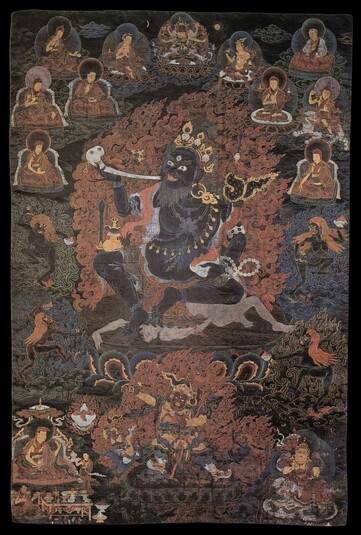
Item: Mahakala (Buddhist Protector) - Brahmarupa (Brahmin Form)
| Origin Location | Tibet |
|---|---|
| Date Range | 1700 - 1799 |
| Lineages | Sakya, Ngor (Sakya) and Buddhist |
| Material | Black Background on Cotton |
| Collection | Private |
Classification: Deity
Appearance: Mahasiddha
Gender: Male
Brahmarupa Mahakala (Tibetan: gon po dram ze, English: the Mahakala who appears in the form of a Brahman). This composition can be dated to circa 1760 with the last two teachers identified as Palden Chogyong (1702-1760) and Migyur Gyaltsen (b.1717). (See the Brahmarupa Outline Page).
Sanskrit: Brahmarupa Tibetan: Dram ze
Tibetan: Dram ze
Iconographic Elements of the Painting: Size, Descending Order & Hierarchy: - Brahmanarupa Mahakala with Four Attendants (large central figure) - Manjuvajra Guhyasamaja (top center) - Lineage Teachers (right & left side) - Begtse Chen with Two Attendants (bottom center) - Vaishravana Riding a Lion (bottom right) - Donor Figure: Rinchen Migyur Gyaltsen (b.1717 [P5947]) (bottom left)
Artistic Elements of the Composition: - Subject: figurative - Composition Type: floating figure - Ground Colour: Black - Painting Style: mixed - Khyenri and New Menri - Region: Tsang Province, Central Tibet - Date: circa 1760 - Inscriptions: names beneath each figure (red lettering) - Special characteristics: (none visible on back) - Artist: unknown at this time
Appearing as an Indian Brahman, dark brown in colour, this unique form Mahakala has one face and two hands. With the right hand he blows on a deer horn trumpet and with the left supports himself on the thigh while holding a skullcup with a white bone mala (string of prayer beads) wrapped around the wrist. The hair, beard and eyebrows are long and flame upward like fire. Wearing bone ornaments and a human skin he sits in a relaxed posture on a human corpse mat, sun disc and multi-coloured lotus.
At the edges of the pristine awareness wisdom fire are four dakinis, ghoulish in appearance, dynamic in posture, Dombini, Chandali, Rakshasi and Singhali Devi - black, red, yellow and green, although dominantly black in colour. They are naked with disheveled orange hair, each holding a curved knife and a skullcup.
Directly above, floating on the clouds, is Manjuvajra Guhyasamaja, orange, with three faces and six hands embracing the consort. At the right and left sides are five figures each with the lowest two being the 25th and 34th Abbots of Ngor Ewam Monastery, Sanggye Puntsog (1649-1705 [P796]) and Palden Chogyong (1702-1760 [P802]).
Descending at the top right are Risulu Dakini, Dragpa Gyaltsen, Ngorchen Kunga Zangpo, Doringpa and Palden Chogyong. Descending on the left side are Nagarjuna, three teachers and then to Sanggye Puntsog.
At the bottom center is Begtse Chen flanked by his consort and son, Mistress of Life and Lord of Life. At the lower right is Vaishravana Riding a Lion.
At the lower left corner is a donor figure with the name inscription of Ewam Rinchen Migyur Gyaltsen (b.1717 [P5947]) of the Luding Labrang and the 37th Great Abbot of Ngor Ewam Monastery.
Short History: When the great Tibetan Translator Nyen Lotsawa received the Manjuvajra Guhyasamaja (also known as the Jnanapada Lineage) empowerment from the dakini Risula, she also bestowed the initiation of the Mahakala (Chaturmukha) in the special form according to the Guhyasamaja Tantra. At this time she gave him as a servant a dark skinned Brahman. When Nyen Lotsawa and the Brahman reached Nepal the servant changed appearance and took on the form of a monk, an appearance more conducive for travelling in Tibet. After the passing of Nyen Lotsawa the monk remained with Lama Nam Ka'upa and then later with Sachen Kunga Nyingpo.
Brahmarupa Mahakala is none other than Chaturmukha Mahakala of the Guhyasamaja Tantra. In his wrathful appearance he is black in colour with four faces and four hands, surrounded by the four dakinis. In the Sakya School it is inappropriate to show the wrathful form to anyone who has not received the initiation. For this reason the iconographic tradition arose for painting Chaturmukha in the form of the Brahman servant of Nyen Lotsawa. At the bottom of many Sakya 'tangkas' it is a common theme to see Panjarnata Mahakala flanked by the Brahman on the right and Shri Devi (Palden Lhamo) on the left - the three main protectors of the Sakya School.
Indian Lineage: Vajradhara, Nagarjuna, Balimtapa, Buddhajnana, Dipamkara Bhadra, Shri Deva, Vimala Gupta, Ratnavajra, Ratnakirti, Risula Dakini, Nyen Lotsawa, Lama Nam Ka'upa, Sachen Kunga Nyingpo, etc.
Jeff Watt 12-2015
Front of Painting
English Translation of Inscription: (Name inscriptions beneath each figure in red lettering).
Reverse of Painting
Special Features: (Printed script (Uchen), includes "Om Ah Hum" inscription)
Collection: Christie's, New York (Painting. March, 2016)
Painting Type: Black Ground Masterworks
Buddhist Protector: Mahakala Masterworks Page
Mahakala: Brahmanarupa Page
Buddhist Deity: Brahmanarupa (Masterworks)
